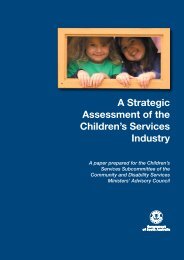Global Study On Child Poverty And Disparities (PDF) - Social Policy ...
Global Study On Child Poverty And Disparities (PDF) - Social Policy ...
Global Study On Child Poverty And Disparities (PDF) - Social Policy ...
Create successful ePaper yourself
Turn your PDF publications into a flip-book with our unique Google optimized e-Paper software.
The deprivation approach to<br />
measuring poverty<br />
Deprivation studies are likely to yield results closer<br />
to the reality of people’s perceptions of poverty<br />
and well-being in Vanuatu. Earlier poverty studies<br />
show that hardship, as perceived by Ni-Vanuatu,<br />
is characterized primarily by lack of or limited<br />
access to basic services such as education,<br />
health, good roads, and safe water supply, which<br />
fits well with the deprivation approach to poverty.<br />
Extensive consultations on appropriate poverty<br />
measures for Vanuatu provided the following<br />
working definition of Pacific poverty or hardship<br />
(ADB, UNDP, Government of Vanuatu, 2008):<br />
• lack of access to basic services such as health<br />
care, education and clean water<br />
• lack of opportunities to participate fully in the<br />
socio-economic life of the community<br />
• lack of access to productive resources and<br />
income generation support systems (rural credit,<br />
capital, markets, skills training) to meet the<br />
basic needs of the household and its customary<br />
obligations to the extended family, village<br />
community and church<br />
Box 3 summarises the deprivation measures<br />
used in this report, which are derived from the<br />
2007 MICS. Deprivation is measured in seven<br />
dimensions – shelter, sanitation, safe drinking<br />
water, information, food, education and health.<br />
Deprivations are measured as severe or less<br />
severe. <strong>Child</strong>ren are defined as being age 0-17<br />
years, but, as noted in the box, some deprivations<br />
are relevant to a smaller age group within that<br />
range.<br />
The discussion of deprivations that follows for<br />
the most part excludes information deprivation,<br />
as lack of access to media (radio, TV, telephone)<br />
was the norm in rural Vanuatu (over 60 per cent)<br />
at the time of the MICS, and counting information<br />
deprivation would considerably increase the<br />
number of children experiencing multiple<br />
deprivations and thus potentially skew the profile<br />
of children’s relative disadvantage.<br />
There is also evidence that information<br />
deprivation has been subject to rapid change, and<br />
the picture provided in the MICS appears to have<br />
altered very significantly following amendments<br />
to the Telecommunications Act in 2007, opening<br />
the telephone market to competition. According<br />
to the Pacific Institute of Public <strong>Policy</strong> (2009),<br />
there has been a rapid increase in mobile<br />
telephone coverage, particularly in rural areas 12<br />
According to the most recent census, 76 per cent<br />
of households in Vanuatu had mobile phones in<br />
2009, with access varying between 71 per cent in<br />
Penama and 87 per cent in Shefa. The two major<br />
exceptions are Tafea (63 per cent) and Torba (10<br />
per cent). The entire country can now receive<br />
the Radio Vanuatu signal—up from 70 per cent<br />
in 2008 and only 15 per cent in 2007. Combined<br />
with the expansion in mobile phone coverage, this<br />
has significantly reduced information deprivation.<br />
Thus, excluding this category is in keeping with<br />
the focus of this report on the pillars of child wellbeing<br />
– areas identified by UNICEF as critical to a<br />
child’s development: health, nutrition, sanitation,<br />
water, and education.<br />
Levels of deprivation<br />
Figure 2.6 shows the occurrence of severe and<br />
less severe deprivations. Some deprivations<br />
are individual (for example, whether a child is<br />
immunised or is attending school), and some are<br />
experienced at the household level (for example,<br />
housing and access to water), but all results<br />
are reported at the individual level. It is readily<br />
apparent that, with the exception of information<br />
deprivation (51 per cent), severe deprivations<br />
are relatively uncommon, ranging between 3 per<br />
cent for severe sanitation deprivation and 5 per<br />
cent for severe education deprivation to 17 per<br />
cent for health deprivation. However, significant<br />
proportions of the child population experience<br />
less severe deprivations, particularly health (65<br />
per cent), information (55 per cent), shelter (44<br />
per cent) and sanitation (38 per cent). Lower but<br />
still significant numbers of children experience<br />
less severe deprivations in the areas of water,<br />
education and food.<br />
Figure 2.6: <strong>Child</strong>ren who are severely and less<br />
severely deprived, 2007 (%)<br />
Shelter<br />
Sanitation<br />
Water<br />
Information<br />
Education<br />
Food<br />
Health<br />
3<br />
5<br />
8<br />
10<br />
14<br />
16<br />
17<br />
23<br />
0 10 20 30 40 50 60 70<br />
Source: Estimated from data in 2007 MICS.<br />
26<br />
38<br />
44<br />
51<br />
55<br />
65<br />
Severe<br />
Less Severe<br />
12 The Pacific Institute of Public <strong>Policy</strong> has noted that 80 percent of rural respondents had<br />
acquired a mobile phone within the year preceding the study, compared to 51 percent of<br />
all respondents. Positive impacts included more contact with family and friends, improved<br />
information on family events, reduced travel costs and increased speed of communication.<br />
There is also a positive relationship between perceived access to telecommunications<br />
and perceived livelihood improvements. However, interviewees with higher cash incomes<br />
expressed anxiety over the added financial burden of having a mobile telephone, including<br />
subsidising relatives’ credit or charging costs. In rural areas in particular, interviewees were<br />
concerned about the unprecedented increases in the speed of information and communication<br />
introduced by mobile telephony (Pacific Institute of Public <strong>Policy</strong> 2009).<br />
44
















